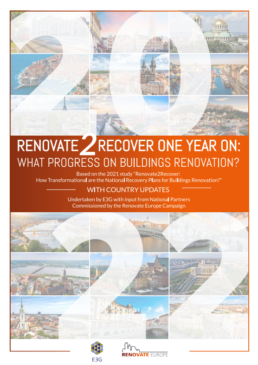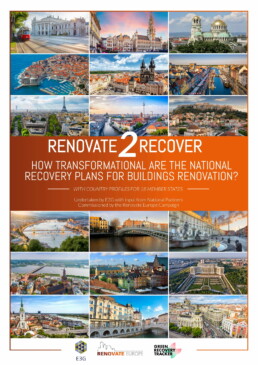Renovate2Recover: How transformational are the National Recovery Plans for buildings renovation?
13 October 2021
The National Recovery and Resilience Plans (NRRPs) were approved in the aftermath of COVID in 2021, well before the war in Ukraine and subsequent energy prices and cost of living crisis. The aim of the Recovery Facility is to provide a stimulus which would lift Member States’ economies out of the post-COVID slowdown, while boosting digitalisation and helping Member States to achieve the EU’s 2030 and 2050 climate goals.
The energy crisis acts as an additional driving force for pursuing the buildings-related reforms and investments planned in the NRRPs. As Commission President von der Leyen stated in October 2022, “faced with war, with a fossil fuel crisis, the arguments in favour of the Renovation Wave have only become more pressing. Investing in renovation is a no regret option.”
In 2021, the Renovate2Recover study found that amongst the 18 Member States’ NRRPs analysed, €39.9bn* was allocated buildings renovation (about 8% of total). This brief provides an update on progress after one year of implementation, and looks at the work which has begun to unlock buildings-related investment worth at least €28bn.
This briefing looks at which buildings-related measures were implemented, which targets and milestones were met, and what financial support was provided to Member States until the end of September 2022. There has been slow but steady progress on buildings-related measures led by reforms and entry into force of new financing programmes.
*This figure has been updated to approx. €46 bn across 18 MS with value for Italy increased from €8.6bn to €15.4bn (original value was based on a draft plan).
The Renovate2Recover Study, undertaken by E3G for the Renovate Europe Campaign and launched on the 13th of October 2021 at the REDay2021 Conference, assesses the buildings-related elements of the National Recovery and Resilience Plans (NRRPs) in 18 Member States: Austria, Belgium, Bulgaria, Croatia, Czechia, Denmark, France, Germany, Greece, Hungary, Ireland, Italy, Latvia, Poland, Romania, Slovakia, Slovenia and Spain. The aim is to understand whether NRRPs position countries to achieve longer-term targets for more and deeper renovation, and whether NRRPs have the potential to be ‘transformational’ on the path to achieving national goals set out in the Long Term Renovation Strategies and EU goals set out in the Renovation Wave strategy. The Study was developed by E3G, bringing its experience of working on the Green Recovery Tracker, and was delivered in close cooperation with Renovate Europe’s National Partners and Campaign Office.
Renovate Europe’s National Partners have made substantial and crucial contributions to the content and value of this Study. They are perfectly positioned with their understanding of the national context and contacts with national governments to contribute to the assessment of the NRRPs, and, crucially, to act on the opportunities that are identified in each Country Profile to improve and support the implementation of NRRPs across the EU.
Each Country Profile is accompanied by an annex that sets out, in more detail, the various programmes and reforms that each Member State includes in its NRRP. Where possible, the funding allocation for each programme is also included. The content of these annexes is drawn from an analysis of the European Commission’s assessment of the NRRPs and the European Council’s Implementing Decision for each NRRP.


